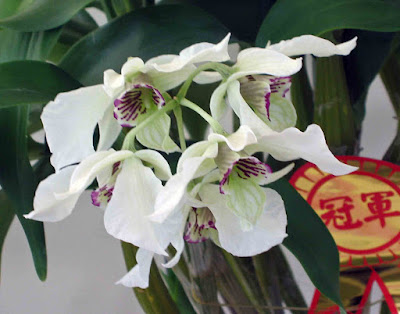Dendrobium rhodostictum occurs from East New Guinea to the island of Bougainville, covering the islands of New Ireland and New Britain. In New Guinea, they grow on trees in mountain rain forests or wet forests, or in the ground on steep, damp, mossy slopes, at heights of 800-1200 m...
Dendrobium rhodostictum also called as The Red-Spotted Dendrobium, Dendrobium madonnae, Sayeria rhodosticta, is a species of the genus Dendrobium. This species was described by Ferdinand von Mueller & Friedrich Fritz Wilhelm Ludwig Kraenzlin in 1894.
IDENTIFY DENDROBIUM RHODOSTICTUM
Dendrobium rhodostictum occurs from East New Guinea to the island of Bougainville, covering the islands of New Ireland and New Britain. In New Guinea, they grow on trees in mountain rain forests or wet forests, or in the ground on steep, damp, mossy slopes, at heights of 800-1200 m.
It is a small to medium sized, warm to cool growing species, which reaching 13-25 cm in height, with basally fusiform to apically swollen, yellow, 3 to 5 noded, 8-23 cm long stems below the 2 to 4, dark green, persistent, leathery, spreading, 5-10 cm long leaves.
The Red-Spotted Dendrobium blooms from March till May and August and September on an erect or arching, short to 7.5 cm, few flowered raceme with 3 to 8, waxy, fragrant flowers that arise from the apex of a cane. The flowers are 6-7 cm in diameter. The white petals of both whorls may have green or purple veins. They are sharp and have bulges. The whale-tail lip has purple dots on the front rim. Their size and quantity is variable. The top of the lip has a small, sharp appendix in the middle of the indentation.
DENDROBIUM RHODOSTICTUM CARE AND CULTURE
Cultural information should only be used as a guide, and should be to be adapted to suit you. Your physical location; where you grow your plants, how much time you have to devote to their care, and many other factors, will need to be taken into account. Only then can you decide on the cultural methods that best suit you and your plants.
Light:
Dendrobium rhodostictum needs a light level of 25000-35000 lux.
Temperature:
The average temperature of the day throughout the year is 25-28 ° C, night 16-17 ° C, giving a daily difference of 10-12 ° C.
Humidity:
The Red-Spotted Dendrobium needs the air humidity throughout the year of 80-85%.
Substrate, growing media and repotting:
These plants can be grown on tree rootstocks or cork, with high humidity is ensured and watering is done at least once a day in summer. When growing in pots, you can use any loose, quickly drying substrate. Repotting can be performed when new roots grow.
Watering:
Precipitation is abundant throughout the year, but it is slightly drier during the winter months. Dendrobium rhodostictum should be kept constantly moist, but not soaked.
Fertilizer:
Weekly or every 2-week 1/4-1/2 dose of recommended fertilizer for orchids is recommended. Balanced fertilizer should be used for a year round.
Rest period:
In winter, Dendrobium rhodostictum are able to survive the temperature drops to 10 ° C, the amount of water and fertilizer should then be slightly reduced, especially when plants are grown in dark and short days at moderate latitudes. However, they can never dry up completely.















COMMENTS